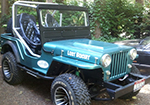This video was part of the press release information by Ford that introduced the new Ford GP. We’ve seen much of this footage previously.
“This black and white 1941 demonstration film, produced by Ford Motion Picture Laboratories and narrated by Michigan sportscaster Harry Wismer, shows U.S. Army Truck, ¼ ton 4×4 Command Reconnaissance vehicles in action at and around the Ford River Rouge Complex in Dearborn, Michigan (TRT 0:23).
Opening titles (0:07). Dedication: “This film is respectfully dedicated to the officers and men of the United States Army in the name of American Industry…” (0:27).
A trio of Ford 4×4 Reconnaissance Cars or GPW “Jeeps” exit a Ford River Rouge Plant garage in single file. Edsel Ford, president of the Ford Motor Company delivers the initial order of 1,500 U.S. Army cars to then-Brigadier General Charles H. Bonesteel III, speaking into a WXYZ radio microphone (0:45).
Under a Jeep’s hood, “the final nuts are turned,” putting the finishing touches on a new “scout car” (W-2017422) in a staged photo-op. The front fenders, wheels, grill, and headlights are seen in closeup (1:12).
Edsel Ford and General Bonesteel climb aboard. Ford smiles behind the wheel and reads a prepared statement (1:24).
Ford shifts the GPW into gear and drives ahead (2:09).
A Ford GPW drives wildly across a snowy Michigan winter landscape, bouncing over hills at high speed. Industrial buildings in the background (2:22).
The three vehicles race past an assembled crowd of onlookers, jumping over a bump in the off-road terrain to demonstrate liftoff. The trio drives straight at the camera head-on from two angles (2:37). In a closer view, the 45 horsepower Jeeps skid into a sharp curve and climb muddy hills with ease (3:01).
Ford and General Bonesteel watch approvingly in closeup (4:02). The GPWs drive over weeds and branches up steep hills (4:08). The Jeeps continue proving themselves, circling around warmly dressed officials in the foreground (4:37). A closeup reveals chained tires. The Jeep, driven by a man in aviator’s goggles, brakes, then drives down a steep hill, seemingly unharmed (4:54). A Jeep carrying two passengers bounces up and down a hill in a loop, dodging barren trees (5:15).
A driver and General Bonesteel behind the windshield. Edsel Ford holds onto his hat in the rear seat. The Jeep proceeds more cautiously, and General Bonesteel grips a canvas side panel (5:55). A GPW splashes through a narrow canal filled with water, spraying streams from either front wheel well (6:35).
Another car with two passengers and its hood flipped open, blocking the windshield. Water splashes over the exposed engine. Steam rises, yet the Jeep continues driving on (6:51). More Jeeps “rolling off the assembly line” of the River Rouge Plant. A wider shot reveals the outline of the Rouge plant, and other early 1940s Ford vehicles parked outside. Jeeps drive over railroad tracks (7:10). A seemingly endless stream of Ford GPWs drive forth from a gated service road (7:21). “The End” (7:33).
President Dwight Eisenhower called the Jeep “one of three decisive weapons the U.S. had during WWII,” and General George Marshall called it “America’s greatest contribution to modern warfare.” The Ford GPW had predecessors in its 1923 4×2 Reconnaissance Car, the Bantam Reconnaissance Car of the American Austin Company, and the Willys MB. Ford’s prototype, the “Pygmy” was approved in 1940. It used a modified Model N tractor motor. The “G” in GPW stood for “Government” contract, the “P” indicated an 80in wheelbase, and the “W” referred to the design and engine licensed from Toledo, Ohio-based Willys-Overland Motors. The original origin of the “Jeep” nickname is debated to this day.”
